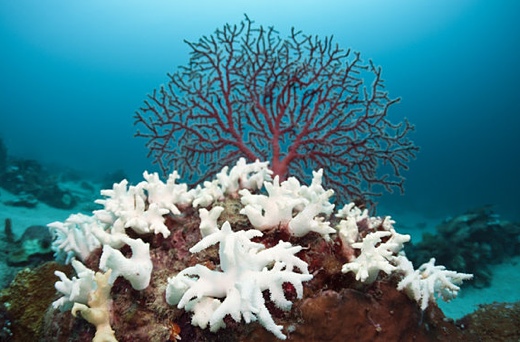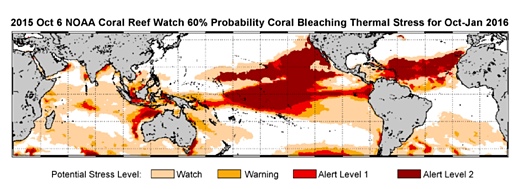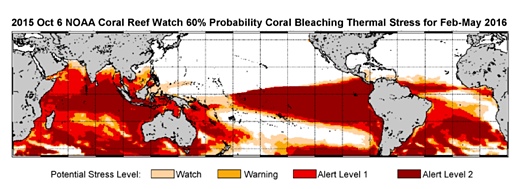SUBHEAD: Here is evidence that something very bad is happening in Earth's oceans.
By Nick Visser on 8 OCtober 2015 for Huffington Post -
(http://www.huffingtonpost.com/entry/coral-bleaching-climate-change_561568d9e4b021e856d33d0f)

Image above: Bleached corals in West Papua, Indonesia. The world's corals are experiencing a mass bleaching as a result of warmer ocean temperatures and other factors. From original article.
The planet's coral reefs are experiencing a mass global bleaching, the National Oceanic and Atmospheric Administration announced on Thursday. The bleaching, only the third event of its type in recorded history, is another troubling sign of the damaging effects of climate change on the planet's health.
Bleaching happens when usually vibrantly colored corals lose their hues and turn bright white due to warmer oceans or other environmental factors. The colorful algae that live in and feed coral polyps leave in stressful times, turning the otherwise breathtaking formations into ghostly shells.
Warmer ocean temperatures are wreaking havoc on the undersea biome, causing widespread damage to delicate coral ecosystems that may well get worse due to the potential effects of a strong El Niño tropical weather system.
Reefs cover about 0.1 percent of the ocean floor, but are home to some 25 percent of marine life and have long been one of the main victims of a hotter world. However, Mark Eakin, the coordinator for NOAA's Coral Reef Watch program, said corals are often out of the public eye simply because they're underwater.
"What do you think people would do if, in a matter of months, 60 percent of the redwood forest would die?" he asked. "It's a bit of a problem of being out of sight, out of mind."
Eakin was referring to a smaller-scale bleaching that took place in the Caribbean in 2005 that wiped out 60 percent of corals in that region, but went relatively unnoticed. Now, however, bleaching is taking place on a much larger scale. Mass bleaching has happened just twice before, Eakin said, once in 1998 and again in 2010.
The current global bleaching began in the northern Pacific in the summer of 2014 and has since expanded throughout the Pacific and Indian Oceans. Corals in the U.S. have been among the hardest-hit, and scientists are particularly concerned with formations around Hawaii and the Caribbean.
The chart below shows the probable threat of bleaching around the globe for the next several months, with the dark red areas showing the places that face the greatest risk.

NOAA's standard 4-month bleaching outlook showing threat of bleaching continuing in the Caribbean, Hawaii and Kiribati, and perhaps expanding into the Republic of the Marshall Islands, from October 2015 to January 2016. From original article. From original article.
When algae leave coral during a bleaching, the reef is left sick, hungry and vulnerable. This doesn't necessarily kill the coral, and some certainly recover. But severe or long-term bleaching -- like the current phenomenon -- is often fatal, according to NOAA. As reefs die, a slew of biodiversity is thrown out of whack. Fish lose their homes, crustaceans leave and many other species die as well.
"After corals die, reefs quickly degrade and the structures corals build erode," a press release from NOAA reads. "This provides less shoreline protection from storms and fewer habitats for fish and other marine life, including ecologically and economically important species."
However, Eakin was quick to note that while the current bleaching event is severe enough, the ongoing El Niño could amp it up to "frightening" levels in the near future, as illustrated below.

Image above: An extended bleaching outlook showing the threat of bleaching expected in Kiribati, the Galapagos, the South Pacific -- especially east of the dateline and perhaps affecting Polynesia -- and most coral reef regions in the Indian Ocean, from February to May 2016.
The news is the latest in a series of troubling climate-related milestones. Last month, NOAA announced that this year's summer had been the hottest in recorded history. In August, scientists said the world's glaciers had melted to the lowest levels since record-keeping began more than 120 years ago. And in March, researchers said Arctic sea ice had seen the smallest annual growth ever.
NOAA's announcement about the bleaching comes a little less than two months ahead of the highly anticipated Paris climate summit in December. Hundreds of world leaders will attempt to devise a global plan for combating climate change, as time is running out to keep the planet below an agreed-upon warming threshold of 2 degrees Celsius.
Oceans will be a key issue during the summit, and Eakin says there's an "absolutely urgent need" for action. By the end of the current bleaching event, he says, some 4,600 square miles of reefs could be dead.
"One of the most heart-wrenching dives I've made in my life was in 2010 during the second global bleaching event," Eakin said of a dive he took in Thailand. "It was just fields of bleached coral. The fish were swimming around in midwater looking stunned."
.
By Nick Visser on 8 OCtober 2015 for Huffington Post -
(http://www.huffingtonpost.com/entry/coral-bleaching-climate-change_561568d9e4b021e856d33d0f)

Image above: Bleached corals in West Papua, Indonesia. The world's corals are experiencing a mass bleaching as a result of warmer ocean temperatures and other factors. From original article.
The planet's coral reefs are experiencing a mass global bleaching, the National Oceanic and Atmospheric Administration announced on Thursday. The bleaching, only the third event of its type in recorded history, is another troubling sign of the damaging effects of climate change on the planet's health.
Bleaching happens when usually vibrantly colored corals lose their hues and turn bright white due to warmer oceans or other environmental factors. The colorful algae that live in and feed coral polyps leave in stressful times, turning the otherwise breathtaking formations into ghostly shells.
Warmer ocean temperatures are wreaking havoc on the undersea biome, causing widespread damage to delicate coral ecosystems that may well get worse due to the potential effects of a strong El Niño tropical weather system.
Reefs cover about 0.1 percent of the ocean floor, but are home to some 25 percent of marine life and have long been one of the main victims of a hotter world. However, Mark Eakin, the coordinator for NOAA's Coral Reef Watch program, said corals are often out of the public eye simply because they're underwater.
"What do you think people would do if, in a matter of months, 60 percent of the redwood forest would die?" he asked. "It's a bit of a problem of being out of sight, out of mind."
Eakin was referring to a smaller-scale bleaching that took place in the Caribbean in 2005 that wiped out 60 percent of corals in that region, but went relatively unnoticed. Now, however, bleaching is taking place on a much larger scale. Mass bleaching has happened just twice before, Eakin said, once in 1998 and again in 2010.
The current global bleaching began in the northern Pacific in the summer of 2014 and has since expanded throughout the Pacific and Indian Oceans. Corals in the U.S. have been among the hardest-hit, and scientists are particularly concerned with formations around Hawaii and the Caribbean.
The chart below shows the probable threat of bleaching around the globe for the next several months, with the dark red areas showing the places that face the greatest risk.

NOAA's standard 4-month bleaching outlook showing threat of bleaching continuing in the Caribbean, Hawaii and Kiribati, and perhaps expanding into the Republic of the Marshall Islands, from October 2015 to January 2016. From original article. From original article.
When algae leave coral during a bleaching, the reef is left sick, hungry and vulnerable. This doesn't necessarily kill the coral, and some certainly recover. But severe or long-term bleaching -- like the current phenomenon -- is often fatal, according to NOAA. As reefs die, a slew of biodiversity is thrown out of whack. Fish lose their homes, crustaceans leave and many other species die as well.
"After corals die, reefs quickly degrade and the structures corals build erode," a press release from NOAA reads. "This provides less shoreline protection from storms and fewer habitats for fish and other marine life, including ecologically and economically important species."
However, Eakin was quick to note that while the current bleaching event is severe enough, the ongoing El Niño could amp it up to "frightening" levels in the near future, as illustrated below.

Image above: An extended bleaching outlook showing the threat of bleaching expected in Kiribati, the Galapagos, the South Pacific -- especially east of the dateline and perhaps affecting Polynesia -- and most coral reef regions in the Indian Ocean, from February to May 2016.
The news is the latest in a series of troubling climate-related milestones. Last month, NOAA announced that this year's summer had been the hottest in recorded history. In August, scientists said the world's glaciers had melted to the lowest levels since record-keeping began more than 120 years ago. And in March, researchers said Arctic sea ice had seen the smallest annual growth ever.
NOAA's announcement about the bleaching comes a little less than two months ahead of the highly anticipated Paris climate summit in December. Hundreds of world leaders will attempt to devise a global plan for combating climate change, as time is running out to keep the planet below an agreed-upon warming threshold of 2 degrees Celsius.
Oceans will be a key issue during the summit, and Eakin says there's an "absolutely urgent need" for action. By the end of the current bleaching event, he says, some 4,600 square miles of reefs could be dead.
"One of the most heart-wrenching dives I've made in my life was in 2010 during the second global bleaching event," Eakin said of a dive he took in Thailand. "It was just fields of bleached coral. The fish were swimming around in midwater looking stunned."
.
No comments :
Post a Comment